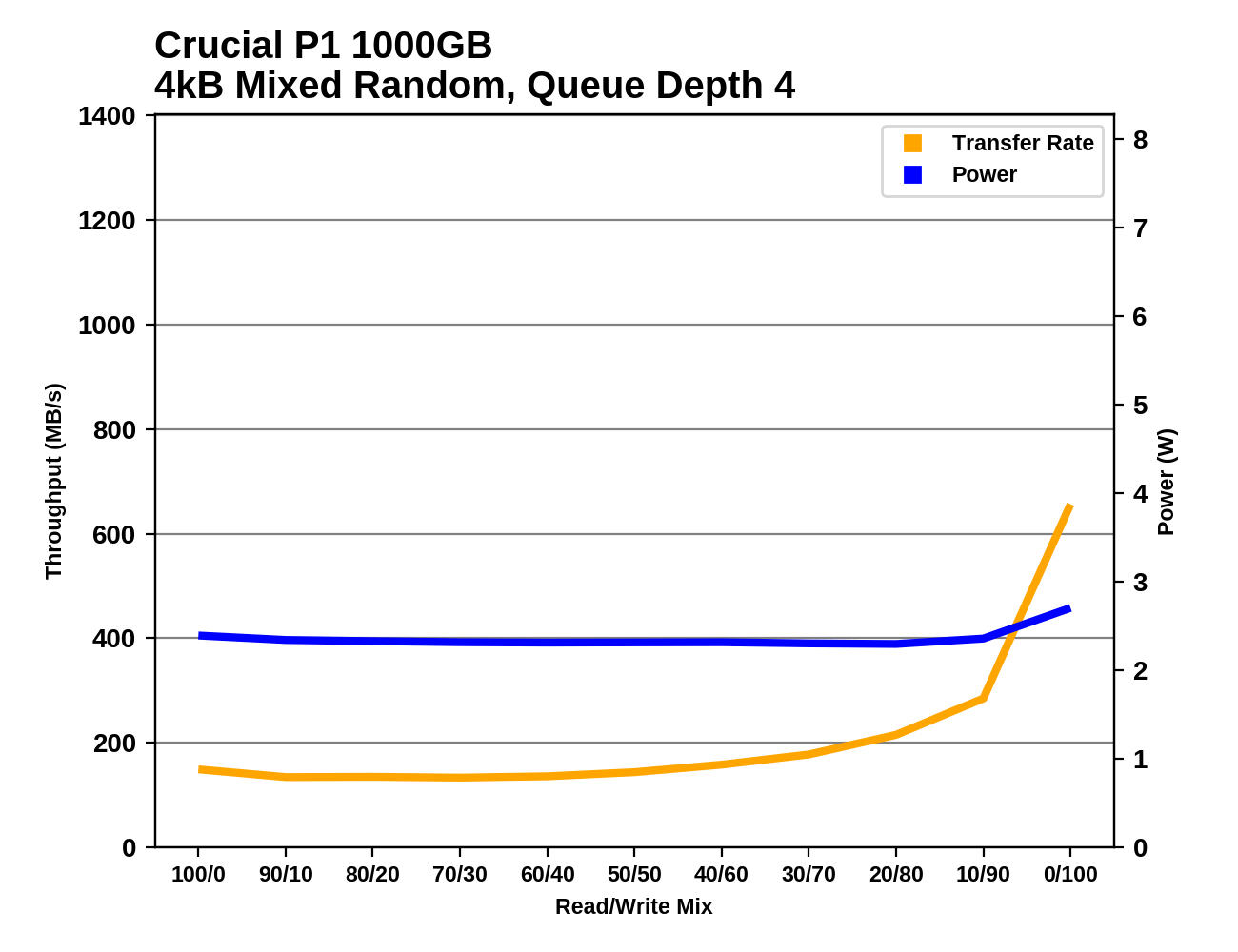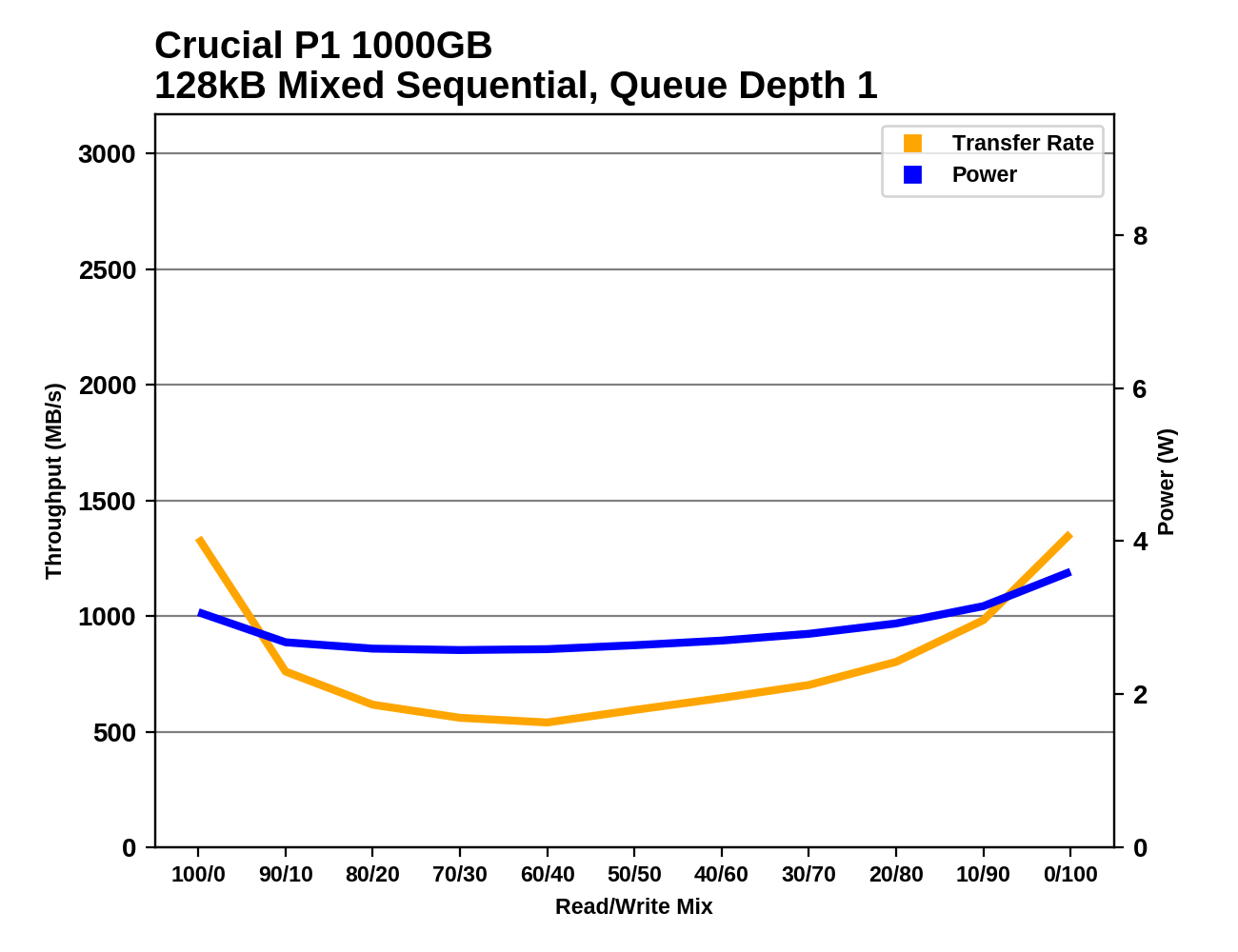The Crucial P1 1TB SSD Review: The Other Consumer QLC SSD
by Billy Tallis on November 8, 2018 9:00 AM ESTMixed Random Performance
Our test of mixed random reads and writes covers mixes varying from pure reads to pure writes at 10% increments. Each mix is tested for up to 1 minute or 32GB of data transferred. The test is conducted with a queue depth of 4, and is limited to a 64GB span of the drive. In between each mix, the drive is given idle time of up to one minute so that the overall duty cycle is 50%.

The Crucial P1 has reasonable entry-level NVMe performance on the mixed random I/O test. It's clearly faster than the MX500 SATA SSD and comes close to some high-end NVMe SSDs. But when the drive is full and the SLC cache is at its minimum size, the P1 slows down to 40% of its speed on a drive containing only the test data. When full, the P1 is about 22% slower than the Intel 660p, but their empty-drive performance is similar.
 |
|||||||||
| Power Efficiency in MB/s/W | Average Power in W | ||||||||
The Crucial P1 has worse power efficiency than the Intel 660p on this test, whether it is run on a full drive or not. The efficiency is still reasonable for the mostly-empty drive test run, but when full the P1's power consumption increases slightly and the efficiency is significantly worse than other low-end NVMe SSDs.
 |
|||||||||
When the mixed random I/O test is run on a full Crucial P1, the benefits of the SLC cache almost completely disappear, leaving the drive with a mostly flat performance curve (with some inconsistency) rather than the significant performance upswing as the proportion of writes grows beyond 70%. The Intel 660p's performance is very similar save for slightly lower write performance to the SLC cache, and slightly improved full-drive performance.
Mixed Sequential Performance
Our test of mixed sequential reads and writes differs from the mixed random I/O test by performing 128kB sequential accesses rather than 4kB accesses at random locations, and the sequential test is conducted at queue depth 1. The range of mixes tested is the same, and the timing and limits on data transfers are also the same as above.

The performance of the Crucial P1 on the mixed sequential I/O test is better than most entry-level NVMe SSDs and comes close to some of the slower high-end drives. Even when the test is run on a full drive, the P1 remains faster than SATA SSDs, and its full-drive performance is slightly better than the Intel 660p.
 |
|||||||||
| Power Efficiency in MB/s/W | Average Power in W | ||||||||
The power efficiency of the Crucial P1 on this test is about average for an entry-level NVMe drive. When the test is run on a full drive, the reduced performance causes efficiency to take a big hit, but it ends up being only slightly less efficient than the Crucial MX500 SATA SSD.
 |
|||||||||
The Crucial P1 has decent performance at either end of the test, when the workload is either very read-heavy or very write-heavy. Compared to other entry-level NVMe drives, the P1 starts out with better read performance and recovers more of its performance toward the end of the test than many of its competitors. The minimum reached at around a 60/40 read/write split is faster than a SATA drive can manage but is unremarkable among NVMe drives. When the test is run on a full drive, performance during the more read-heavy half of the test is only slightly reduced, but things get worse throughout the write-heavy half of the test instead of improving as write caching comes more into play.










66 Comments
View All Comments
Billy Tallis - Thursday, November 8, 2018 - link
I think you were looking at the price for the 1TB 970 EVO. The 1TB 970 PRO is currently $392.99 on Amazon, closer to twice the price of the Crucial P1. I think it is occasionally reasonable to get something like the 970 EVO for a high-end system. Going past that to a 970 PRO isn't reasonable.PeachNCream - Thursday, November 8, 2018 - link
Whoops, you're correct! Please accept my apologies for that one.DigitalFreak - Friday, November 9, 2018 - link
Even then, the 970 EVO wipes the floor with the P1.Death666Angel - Thursday, November 8, 2018 - link
Who wants QLC NVME drives as the first widely available consumer QLC tech? Not me I tell you! :DI am fine with 3D TLC for my performance needs both from a performance and price point at the moment. 500GB is enough for many casual enthusiasts and 1TB isn't too expensive either. I'd really like 2.5" SATA and M.2 SATA QLC for my casual media storage needs.
Lolimaster - Friday, November 9, 2018 - link
QLC is such useless product except for manufactures, they give you a WORST product for basically the same price or more than a TLC.MX500/860 EVO 1TB for $160-180.
Lolimaster - Friday, November 9, 2018 - link
*Edit 155-160.piroroadkill - Friday, November 9, 2018 - link
QLC doesn't seem to make any sense in an M.2 PCIe NVMe format - it's just really slow compared to even a good SATA 6Gbps SSD. QLC seems to make sense in a 2.5" SATA format, with an enormous capacity. 1TB makes no sense for this shitty performance level. It needs to be there to replace larger drives. Actually, even that makes no sense for a home user - where long term retention is more important, and a hard disk is therefore more useful. QLC drives will probably come into their own at the ~4TB mark in Enterprise storage arrays as a mid-tier storage solution, with hard disks under, and MLC NAND above.crotach - Friday, November 9, 2018 - link
Oh dearThe_Assimilator - Friday, November 9, 2018 - link
Why the bloody bejesus do these manufacturers keep tying ever-slower NAND to ever-faster interfaces? If you want your bloody QLC NAND to be a success, Crucial, make a 2TB+ SATA SSD that costs less per gigabyte than any other SSD on the market, and watch them fly off the shelves. You already got this right with the Micron 1100 series that uses 3D TLC NAND, why can't you do it for QLC?The_Assimilator - Friday, November 9, 2018 - link
Ah, I see that Micron is touting their "5210 ION" series SSDs (using 3D QLC NAND) as "hard drive replacements", and they start at 2TB. Write speeds are not great, but I don't care and I doubt most consumers looking for high-capacity SSDs will either. Hopefully there will be stock of these in time for Black Friday!